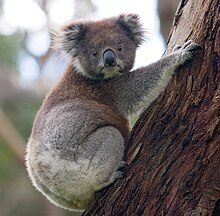The drop bear (sometimes dropbear) is a hoax in contemporary Australian folklore featuring a predatory, carnivorous version of the koala. This imaginary animal is commonly spoken about in tall tales designed to scare tourists. While koalas are typically docile herbivores (and are not bears), drop bears are described as unusually large and vicious marsupials that inhabit treetops and attack unsuspecting people (or other prey) that walk beneath them by dropping onto their heads from above.[1][2][3][4][5][6]

Origin
The origin of the drop bear myth is unknown. It has been attributed to a sketch in Paul Hogan's comedy show The Paul Hogan Show in which koalas jump out of the trees and attack a man. However, others say it began as a scary story for children, or as a trick played on soldiers visiting Australia for training.[7]
A 1967 article in Army, the Australian Army's newspaper, mentions "a dreaded Drop Bear",[8] and a 1976 article about an army base refers to "the legends and stories of drop bears and hoop snakes that supposedly originated there".[9] Other early appearances in print include a Royal Australian Navy News article in 1978[10] and a classified advertisement in the Canberra Times in 1982.[7]
Stories and tall tales
Stories about drop bears are generally used as an in-joke intended to frighten and confuse outsiders while amusing locals, similar to North American "fearsome critters" such as the jackalope.[11] Tourists are the main targets of such stories.[12][13] These tales are often accompanied by advice that the hearer adopt various tactics purported to deter drop bear attacks—including placing forks in the hair, having Vegemite or toothpaste spread behind the ears or in the armpits, urinating on oneself, and only speaking English in an Australian accent.[5][14][full citation needed]
Popularisation
The website of the Australian Museum contains an entry for the drop bear written in a serious tone similar to entries for other, real, species. The entry classifies the drop bear as Thylarctos plummetus and describes them as "a large, arboreal, predatory marsupial related to the koala", the size of a leopard, having coarse orange fur with dark mottling, with powerful forearms for climbing and attacking prey, and a bite made using broad powerful premolars rather than canines. Specifically it states that they weigh 120 kilograms (260 lb) and have a length of 130 centimetres (51 in).[15] The tongue-in-cheek entry was created for "silly season".[16][17] The Australian Museum also established a small display in the museum itself, exhibiting artefacts which it stated "may, or may not, relate to actual drop bears."[17]
Australian Geographic ran an article on its website on 1 April 2013 (April Fools' Day) purporting that researchers had found that drop bears were more likely to attack tourists than people with Australian accents.[18] The article was based on a 2012 paper published in Australian Geographer, and despite referencing the Australian Museum entry on drop bears in several places, images included with the Australian Geographic article were sourced from Australian Geographer and did not match the Australian Museum's species description.[5][15][18]
The drop bear hoax, using a polar bear, was humorously referenced in an advertisement for Bundaberg Rum.[19]
In the Discworld novel The Last Continent by Terry Pratchett, drop bears inhabit the continent of Fourecks,[a] a land portrayed as a parody of Australia. This version of the drop bear tale shows the animals with well-padded backsides to cushion their fall.[20]
Australian Chris Toms and New Zealand musician Johnny Batchelor formed a band named "The Dropbears" in 1981.[21]
See also
Notes
- ^ Australian beer Castlemaine XXXX is known colloquially in the United Kingdom as 4X.
References
